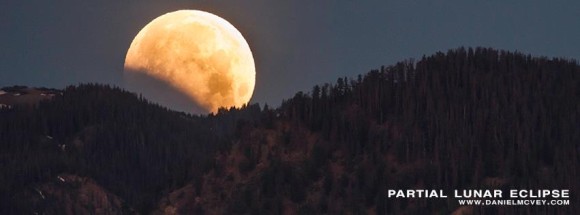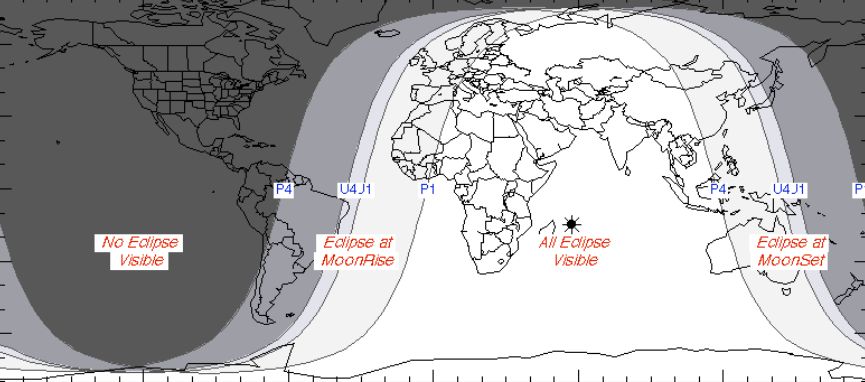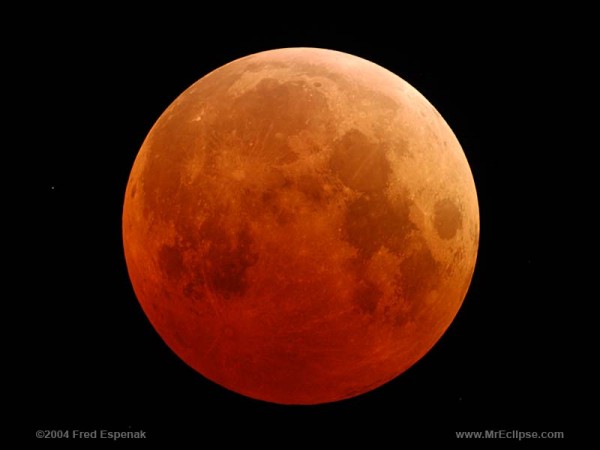In 2013, there will be three lunar eclipses – a 27-minute partial on April 25-26, and two penumbrals. The 2013 lunar eclipses will be interesting, as always, despite the fact that none will be total. There’s info about each eclipse in this post. But first … the upcoming lunar eclipse, a partial, on April 25-26, 2013. Its main distinction is that it’ll be the third-shortest partial lunar eclipse of the 21st century. Only a tiny sliver of the moon will be covered by the Earth’s umbral shadow at maximum eclipse. We in North America won’t be able to see this eclipse. It’ll be daytime for us – and the moon will be down – for the entire thing. The April 25, 2013 partial lunar eclipse will be visible over Europe, Africa, Asia, and Australia.

Follow the links below to more info on upcoming lunar eclipses.
Details on April 25-26 partial lunar eclipse – how to observe – who will see it.
When are the next lunar eclipses in 2013?
Difference between total, partial and penumbral lunar eclipses?
What is the shortest lunar eclipse of this century?
When is the next total lunar eclipse?


When are the next lunar eclipses in 2013? As mentioned previously, 2013 has three lunar eclipses, one partial and two penumbral. The dates are as follows:
April 25: Partial lunar eclipse visible from Europe, Africa, Asia and Australia.
May 25: Penumbral lunar eclipse from the Americas and Africa probably too shallow to be visible.
October 18: Penumbral lunar eclipse visible from the Americas, Europe, Africa and Asia.

Difference between total, partial and penumbral lunar eclipses? These various kinds of lunar eclipses stem from the same source: an alignment, or near alignment, of the Earth, sun and moon in space with Earth in the middle. At any lunar eclipse, Earth’s shadow falls on the full moon. The amount of shadow covering the moon’s face at mid-eclipse creates the three varieties of lunar eclipses.
Every lunar eclipse starts (and ends) with a penumbral eclipse. That’s when Earth’s light, outer, penumbral shadow just brushes the moon’s face. Some people say they can’t see a penumbral eclipse, even when one is going on right before their eyes! You have to be an observant person to enjoy one.
A partial eclipse happens when the alignment of the sun, Earth and moon is more precise, and the Earth’s dark, central, umbral shadow falls on the moon. During a partial eclipse, it appears as if a dark bite is taken from one edge of the moon. Every total eclipse starts (and ends) with a partial eclipse.
What is the shortest lunar eclipse of this century? According to NASA’s eclipse page, the shortest eclipse of the 21st century will be on February 13, 2082, a partial eclipse of the moon lasting only 25.5 minutes. NASA data also indicates that, on September 28, 2034, the second-shortest partial eclipse will last for 26.7 minutes. The April 25-26, 2013 partial lunar eclipse will last for 27 minutes, making it the third-shortest lunar eclipse of this century.
For each of these three very short lunar eclipses, there will be great penumbral eclipses. Be sure to watch for the beautiful penumbral eclipse this week, on April 25-26. The penumbral eclipse will come before and after the partial eclipse.

When is the next total lunar eclipse? A total eclipse is, of course, the most dramatic of the three kinds of eclipses. Then the alignment between the sun, Earth and moon is perfect, and Earth’s dark umbral shadow completely covers the moon’s face. Sometimes, if there is a lot of volcanic dust in Earth’s atmosphere, Earth’s shadow on the moon can appear very dark at mid-eclipse. But usually the shadow appears blood-red due to the presence of some sunlight filtering through Earth’s atmosphere, and falling, via the shadow, on the face of the moon. It’s a beautiful sight to see.
The next total lunar eclipse is April 15, 2014 visible from the Americas, Australia and out in the Pacific Ocean.
There are from four to seven eclipses each year – some partial, some total, some solar, some lunar. But from your location on Earth, you can’t see every eclipse. Total solar eclipses are seen only along a narrow band across Earth’s surface – a swath cut by the moon’s shadow as it sweeps across Earth during the eclipse. Total lunar eclipses are more widely seen. An entire hemisphere of Earth can watch simultaneously as a total lunar eclipse takes place. But you do have to be able to see the moon, and only half of Earth can do that at any one time.
The video below, from NASA, has a lot of good info about lunar eclipses, and explains why the moon turns blood red during a total lunar eclipse.
So we’ve learned that there are lots of eclipses, and several different kinds of eclipses, but you have to be in the right place on the globe to see them.
When you hear of an eclipse visible for your part of the globe – whether that’s North America or elsewhere – be aware that it’s a very special event. Then, if you can, go outside, and watch it!
Bottom line: When is the next lunar eclipse? In 2013, there are three eclipses: one partial and two penumbral. The next lunar eclipse will be April 25, 2013. It’s a partial lasting only 27 minutes, the second-shortest eclipse of the 21st century! The next total lunar eclipse will be April 15, 2014.
Five best things to see during a lunar eclipse, from the moon











